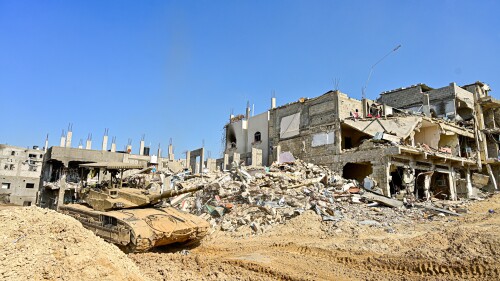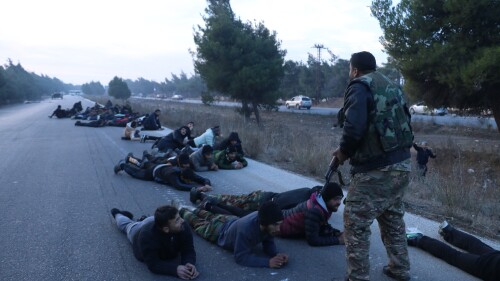Originally published under the title “Who Will Dominate the Post-Islamic State Landscape in Iraq and Syria?”
Iraqi soldiers clear the road to a government complex in the Dawasa neighborhood of western Mosul, Iraq, on March 7. |
On the surface, the wars in Syria and Iraq are continuing at full intensity. The fight between Iraqi government forces and Islamic State in western Mosul is proving a slow, hard slog.
This week, government forces captured the police directorate and the courts complex in the city, moving toward the denser warren of the Old City. The jihadists are fighting for every inch of ground.
Further west, the US-supported Syrian Democratic Forces (SDF) succeeded in cutting the last road from the Islamic State capital of Raqqa to its stronghold in Deir al-Zor.
In the fight between the Assad regime and the Sunni Arab rebellion against it, a rebel attempt at a counterattack in the city of Deraa has led to renewed bloodshed. The regime is continuing its attacks on rebel-held Eastern Ghouta east of Damascus, despite a new Russian-brokered cease-fire.
But while the tactical contests are continuing, the general direction of events in both the war against Islamic State and the fight between Assad and the rebels is now clear.
US-backed Syrian Democratic Forces (SDF) fighters on the northern outskirts of Deir Ezzor, Syria. |
Islamic State is on its way to ceasing to exist as an entity controlling significant territory. This process is set to continue many months. But having lost tens of thousands of fighters and with the flow of recruits drying up, facing enemies with complete control of the skies and vast superiority in numbers and equipment, Islamic State has no means of reversing the trend.
In Assad’s war further west, meanwhile, the rebellion is in retreat, and its eventual eclipse seems a near certainty.
The regime, with its Iranian, Russian and Hezbollah allies, is seeking to reduce and destroy isolated rebel-held enclaves in the midst of regime-held territory in western Syria. Hence the attacks on Eastern Ghouta and on al-Wa’er in the Homs area. Once this is done, the pro-regime forces may well turn their attention to southwest Syria and eventually also to rebel-held Idlib province in the north.
The regime is also now engaging in the war against Islamic State. Government forces reached the Euphrates River this week, after sweeping through Islamic State-held territory in the east Aleppo countryside.
As the direction of events becomes clear, so the possibility emerges of the Iran-led alliance achieving an overall victory in the Syria and Iraq wars.
Such a victory would, on the face of it, constitute an achievement for Assad. But the Syrian dictator’s own forces are entirely dependent for advances on the Iranian Revolutionary Guards, Hezbollah, Iraqi Shi’a militia forces and paramilitary formations created by the Iranians to address the regime’s manpower shortages over the last five years.
That is, the real power behind such a victory would be Iran-arranged forces on the ground. These, in turn, are capable of moving forward only in cooperation with Russian air power, as events in Aleppo and the northwest have shown.
Such an outcome is still distant and by no means certain. But it is no longer an impossibility, and Israeli and US planners will be noting its feasibility, and seeking ways to prevent it or reduce its impact.
What would such a victory look like? It would include the following elements.
First, the Assad regime would succeed in terminating or severely reducing the remaining areas held by the Sunni Arab rebels and Islamists in the western part of the country.
Second, following the destruction of Islamic State-held areas in eastern Syria, regime forces supported by Russian air power would succeed in heading eastward, challenging or co-opting Kurdish and remaining rebel forces in the area, and reaching the Syrian-Iraqi border.
Third, following the reduction or destruction of Islamic State in Nineveh province, the Iraqi Shi’a militias organized in the framework of the Popular Mobilization Units would remain under arms, becoming a permanent feature of the Iraqi political and military landscape. The Iraqi parliament in late November passed a law making the PMU a permanent part of the Iraqi security forces.
PMU deputy commander Abu Mahdi al-Muhandis (right) with Iranian Quds Force commander Qassem Suleimani. |
The 100,000 fighters of the PMU do not consist solely of pro-Iranian elements. But the main militias and de facto command structures are in the hands of pro-Iranian forces. Most significantly, the Badr Corps of Hadi al-Ameri and the Kata’ib Hezbollah group of Abu Mahdi al-Muhandis are directly linked to Iran’s Revolutionary Guards.
The militias are now located west of Mosul city, close to the town of Tel Afar. If regime forces push eastward, they will link at the border with their comrades of the PMU, creating a massive contiguous area of de facto Iran-controlled territory all the way from deep inside Iraq across Syria and into Lebanon.
That is what victory for the Iran-allied side in the wars in Syria and Iraq would look like. How might it be prevented?
Advances for the Iranian side are possible only with the support of Russian air power. And Russian goals in Syria (Iraq is less significant for Moscow) do not necessarily dovetail with Tehran’s. Iran wants total victory, the reunification of Syria under Assad’s nominal control, and the emergence of the Iran-led Shi’a militias as the key power-holders in Iraq.
Iran wants total victory, whereas Russia is content to be the main broker in a divided Syria.
Moscow had and has far more limited goals. The Russians in Syria wanted to prevent Assad’s defeat, secure their naval assets on the Mediterranean and make themselves the main broker in the subsequent frozen or semi-frozen conflict.
There is a large gap between these two agendas, and working on and widening it should be foremost in the minds of both Western and Israeli policy-makers.
The Russians need to understand that while their own perceived vital interests in Syria can be accommodated, the far more ambitious Iranian agenda in the area crosses Western and Israeli redlines, and therefore will not be allowed to achieve its goals. Without the Russians, Western and Israeli efforts to contain and turn back the Iranians can proceed apace.
Whereas Russia’s perceived vital interests in Syria can be accommodated, Iran’s cannot.
This can be achieved through a combination of diplomatic efforts and facts on the ground. Regarding the former, Prime Minister Benjamin Netanyahu, on his visit to Russia, will presumably be making clear to Russian President Vladimir Putin that Israel’s security redlines regarding an Iranian and Hezbollah creation of a new conflict line east of Quneitra crossing, and regarding the need to prevent permanent Iranian bases in western Syria, are serious, will be pursued, and can be achieved with no threat to Russian vital interests.
Regarding the latter, as of now the key force in Syria fighting Islamic State is the US-aligned SDF. The latest reports indicate that elements of the US Army 75th Ranger Regiment and of the 11th Marine Expeditionary Unit are deploying in eastern Syria to support the fight against Islamic State in this area.
Ownership by the US and its allies of eastern Syria in the post-Islamic State period is the best way to prevent the possibility of the realization of Iran’s aims, while presenting Russia with a fait accompli. The indications are that the US administration is thinking in these terms. If so, Iranian victory emerging from the ruins of Syria and Iraq can be prevented.
The post-Islamic State landscape in Iraq and Syria is emerging. The contest for primacy within it is set to begin.
Jonathan Spyer, a fellow at the Middle East Forum, is director of the Rubin Center for Research in International Affairs and author of The Transforming Fire: The Rise of the Israel-Islamist Conflict (Continuum, 2011).










